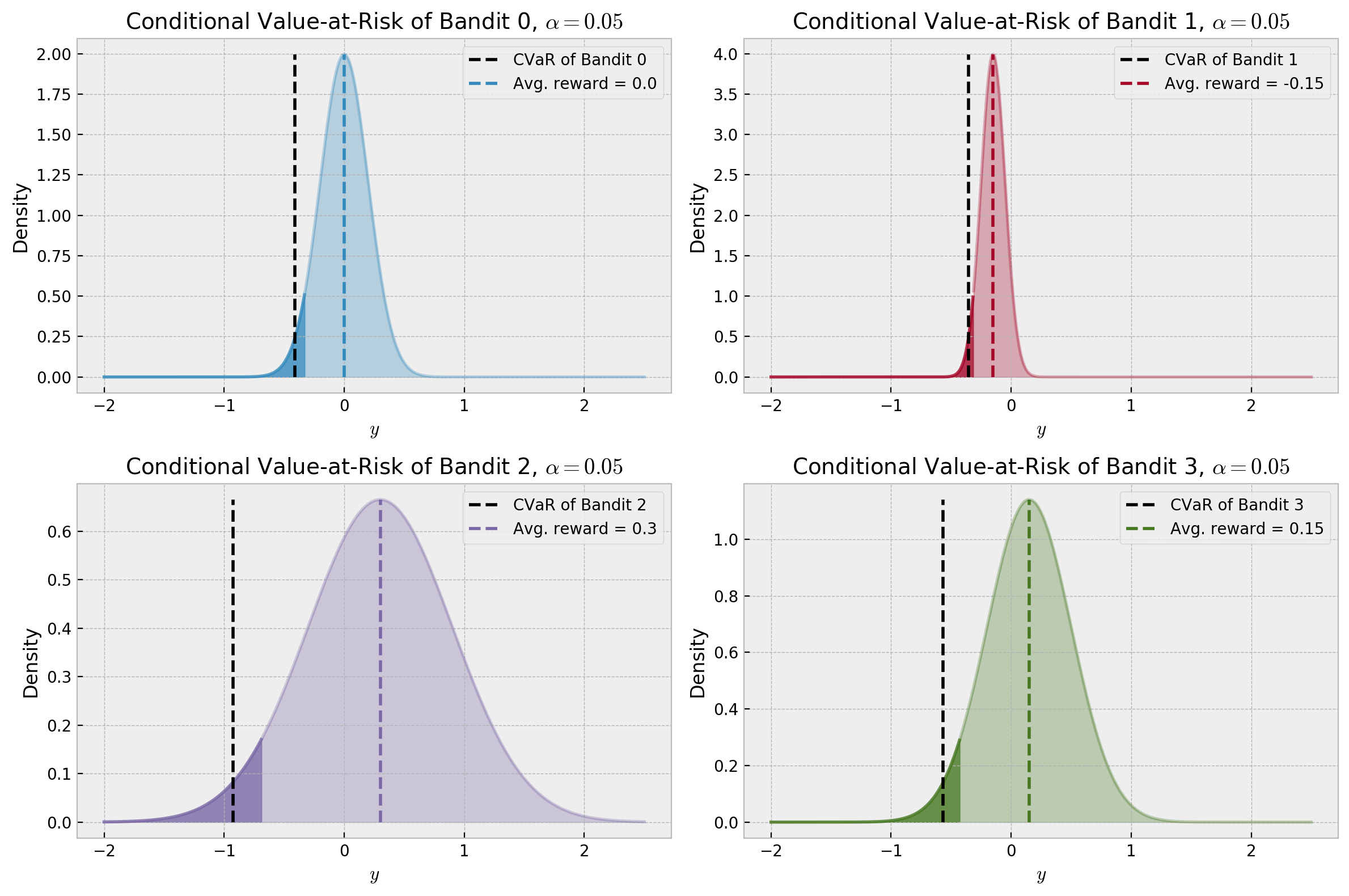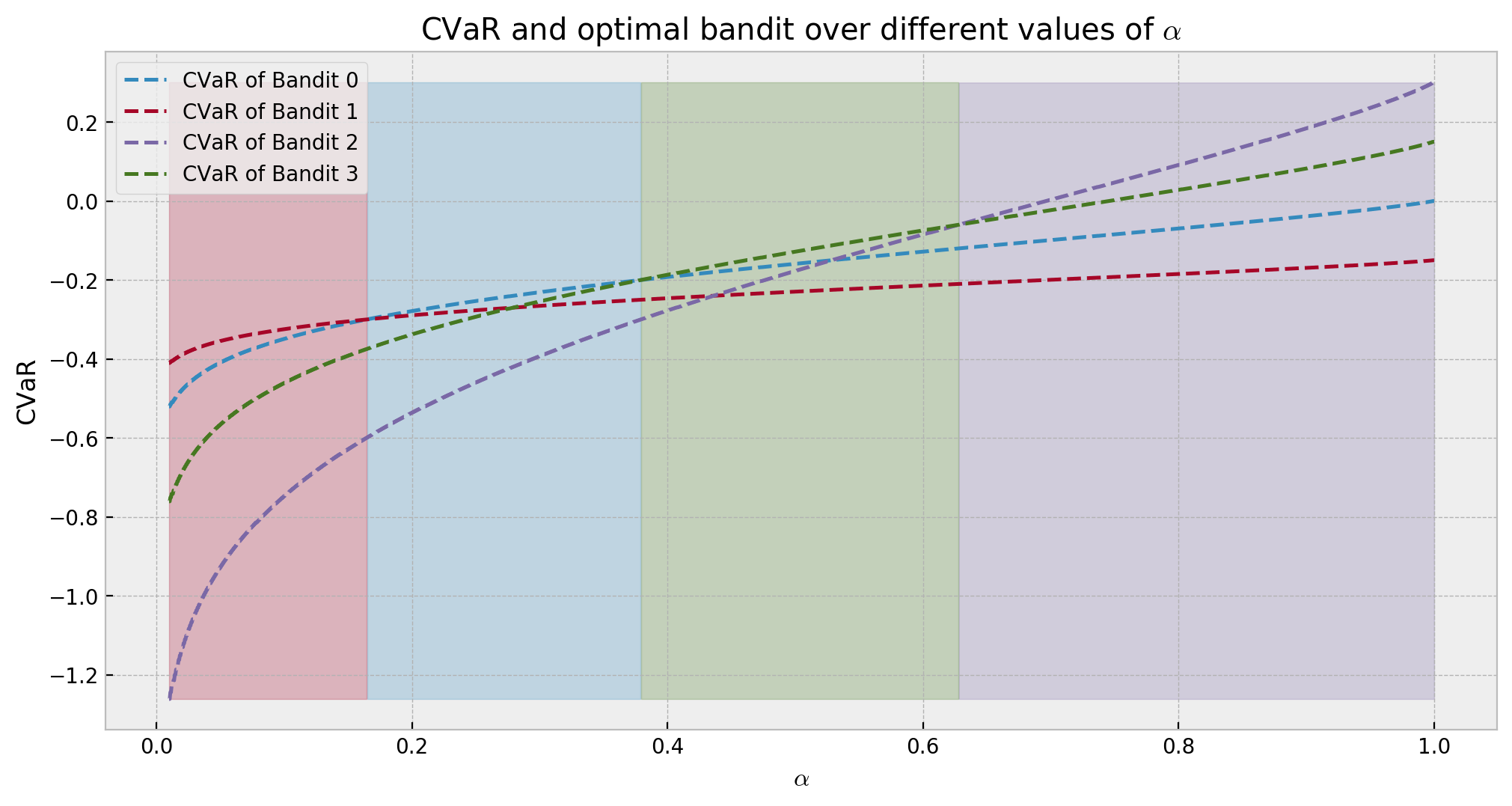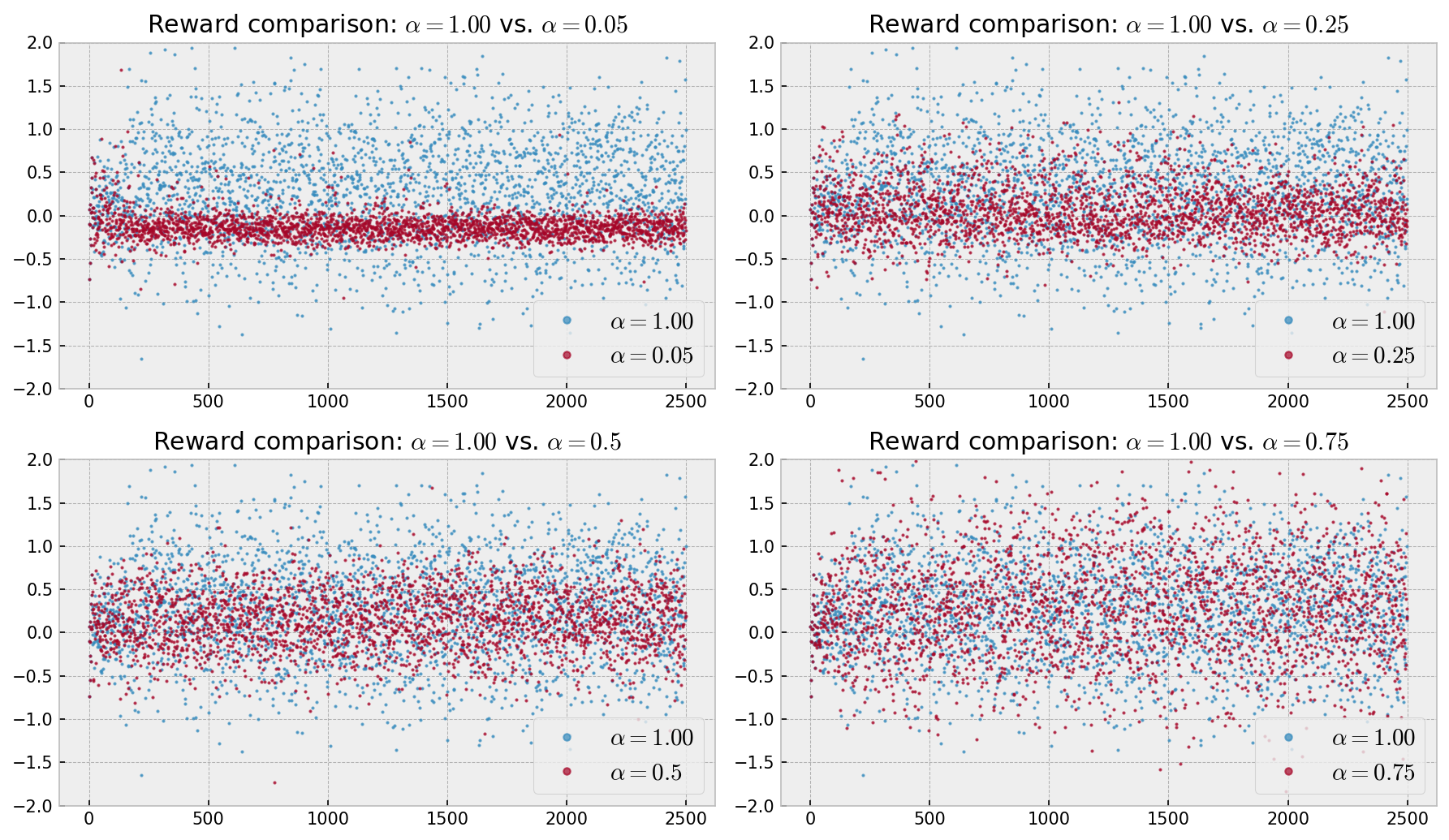Let us explore an alternate case of the Multi-Armed Bandit problem where we have reward distributions with different risks. I’ll draw inspiration from Galichet et. al’s (2013) work and implement the MaRaB algorithm and compare it to Thompson Sampling and Bayesian UCB.
Gaussian Bandit with different risks
Let us borrow the problem from our previous post but change it up a bit by building a bandit problem where reward distributions have different variances. Each bandit $k$ is modeled as a random variable $Y_k \sim \mathcal{N}(\mu_k, \sigma_k^2)$, as in my last post, but with the following twists:
- We use different $\sigma_k$’s for each bandit: particularly, I’ll build the problem such that bandits with higher $\mu_k$ also have higher $\sigma_k$
- We use a different measure of regret: since we started considering risk, our regret measure must reflect that. Thus, we use Conditional Value-at-Risk (CVaR) as our regret measure:
where $\textrm{CVaR} _{best}(\alpha)$ is the best CVaR and $\textrm{CVaR} _{k}(\alpha)$ is the CVaR of chosen bandit $k$. The quantity $\alpha \in [0, 1]$ controls the amount of risk we desire to take. We define $\textrm{CVaR} _{k}(\alpha)$ as the average reward of bandit $k$ on the worst $\alpha \times 100\%$ of its possible outcomes (lower $\alpha$-quantile):
\[\large \textrm{CVaR}_{k}(\alpha) = \mathbb{E}[Y_k\ \vert\ Y_k \leq VaR_{Y_k}(\alpha)]\]$VaR_{Y_k}(\alpha)$ is the Value-at-Risk of $Y_k$, which is equal to its $\alpha$-quantile.
When $\alpha \to 1$, we do not care about risk and aim to choose the bandit with maximal expected rewards $\textrm{argmax}_k(\mu)$. Conversely, when $\alpha \to 0$, we are completely risk-averse and aim to choose the bandit with the best minimum (worst-case) reward. The following code implements the game:
# class for our row of bandits
class GaussianMABCVaR:
# initialization
def __init__(self, mu, sigma, alpha):
# storing mean and standard deviation vectors
self.mu = mu
self.sigma = sigma
self.dist = [norm(self.mu[i], self.sigma[i]) for i in range(len(self.mu))]
self.cvar_bandits = [self.cvar(i, alpha) for i in range(len(self.mu))]
self.alpha = alpha
# function that helps us draw from the bandits
def draw(self, k):
# we return the reward and the regret of the action
return self.dist[k].rvs(1)[0], self.cvar_regret(k)
# CVaR calculation for risk-aware bandits
def cvar(self, k, alpha):
# grid for calculating cvar at lowest alpha-quantile
grid = np.linspace(0.001, 0.999, 1001)
# quantile values over the grid
percentiles = self.dist[k].ppf(grid)
# CVaR is average of quantile values below the alpha-quantile
return percentiles[grid < alpha].mean()
# CVaR regret from choice to best CVaR
def cvar_regret(self, k):
# returning our choice vs. best bandit
return np.max(self.cvar_bandits) - self.cvar_bandits[k]
We can create an instance of our game just like in the previous post, only adding an alpha variable to guide CVaR calculation:
# parameters
mu_rewards = [0.00,-0.15,0.30,0.15]
sd_rewards = [0.20, 0.10,0.60,0.35]
alpha = 0.05
# instance of our risky MAB
gmab = GaussianMABCVaR(mu_rewards, sd_rewards, alpha)
I parameterized the game such that bandits with highest expected rewards also have higher risk. Thus, the optimal bandit will change with our risk appetite parameter $\alpha$. Let us check our reward distributions highlighting their $\alpha$-quantile and their CVaR value:

For the conservative value of $\alpha = 0.05$, the optimal bandit is actually the one with lowest expected reward. How would CVaR values change with $\alpha$, for each bandit? Let us check in the plot below:

The shaded areas indicate which bandit is optimal at each risk appetite. As our risk increases with expected rewards, we see that the bandits with higher $\mu_k$ turn optimal in more aggressive scenarios. Also, we observe that the optimal CVaR is less than zero up until a certain $\alpha$ around 0.65. In a real application, if we had such conservative risk appetite, it would be better to take no action.
Multi-Armed Risk-Aware Bandit (MaRaB)
The Multi-Armed Risk-Aware Bandit (MaRaB) algorithm was introduced by Galichet et. al’s in their 2013 paper “Exploration vs Exploitation vs Safety: Risk-Aware Multi-Armed Bandits”. It selects bandits according to the following formula:
\[\large \textrm{select}\ k_t = \textrm{argmax}\Bigg\{ \widehat{\textrm{CVaR}_k(\alpha)} - C\sqrt{\frac{log(\lceil t\alpha \rceil)}{n_{k,t,\alpha}}}\Bigg\}\]The quantity $\widehat{\textrm{CVaR} _k(\alpha)}$ is the average of the empirical $\alpha$-quantile given observations at time $t$, $\sqrt{\frac{log(t\alpha)}{n _{i,t,\alpha}}}$ is a lower confidence bound on the CVaR, $n _{k,t,\alpha}$ is the number of observations (rounded to ceiling integer) in the $\alpha$-quantile for bandit $k$ at time $t$, and $C$ is a parameter controlling exploration.
We can see that this algorithm is very conservative: it features a negative exploration term, which disencourages exploration, such that if two bandits have the same estimated CVaR, it will favor the one which has been selected more often in the past. However, while the $\alpha$-quantile contains only one sample, it will explore a bit as the CVaR will be a monotonically decreasing function with respect to the number of plays, making bandits that were selected few times look better. The implementation follows:
# class for the marab algorithm
class MaRaB:
# initalizing
def __init__(self, alpha, C):
# storing parameter values
self.alpha = alpha
self.C = C
# function for calculating CVaR
def get_empirical_cvar(self, obs):
# calculating
return np.array(sorted(obs))[:np.ceil(self.alpha*len(obs)).astype(int)].mean()
# function for choosing next action
def choose_bandit(self, k_list, reward_list, n_bandits, round_id=0):
# converting to arrays
k_list = np.array(k_list)
reward_list = np.array(reward_list)
# list accumulating scores
scores_list = []
# loop for each bandit to perform inference
for k in range(n_bandits):
# filtering observation for this bandit
obs = reward_list[k_list == k]
# if we have at least one observation
if len(obs) > 0:
# calculating empirical cvar
empirical_cvar = self.get_empirical_cvar(obs)
# calculating lower confidence bound
lcb = np.sqrt(np.log(np.ceil(self.alpha*len(k_list)))/np.sum(k_list == k))
# adding score to scores list
scores_list.append(empirical_cvar - self.C * lcb)
# if not, score is infinity so we sample this arm at least once
else:
scores_list.append(np.inf)
# casting to array type
scores_list = np.array(scores_list)
# returning bandit choice
return np.random.choice(np.flatnonzero(scores_list == scores_list.max()))
Let us observe it playing for 200 rounds with the following animation of rewards over time. In the animation, each horizontal line represents one of our four bandits and rewards are represented by dots with size proportional to the reward. We use $\alpha = 0.50$, so the green bandit should be optimal.
We can see in practice the risk-averse behavior of MaRaB, exploring very little. This lack of exploration may be a problem, making it harder to the algorithm converge to the best bandit.
Let us now experiment with two bayesian algorithms of increasing popularity, and compare them to MaRaB: Bayesian UCB and Thompson Sampling.
Bayesian UCB and Thompson Sampling
Bayesian algorithms for reinforcement learning are attracting much interest recently, due to their great empirical performance and simplicity. I bring two strong contestants for this post: Bayesian Upper Confidence Bound, for which we draw inspiration from Kaufmann et. al, 2012, and Thompson Sampling, which has been thoroughly studied by Van Roy et. al, 2018.
Both algorithms depend on calculating the posterior distribution for the quantity of interest, which in our case is the Conditional Value-at-Risk for a given risk appetite $\alpha$. In my last post I explore approximate inference techniques that could solve this problem. In this case, Bootstrapping seems like a good alternative, as it offers flexibility to compute the potentially complicated CVaR posterior. Therefore, let us start by implementing it.
Approximating the CVaR posterior with Bootstrapping
The code below is borrowed from my last post. It basically returns bootstrap samples of the data. We avoid uncertainty underestimation in early rounds by setting min_obs such that we only start taking bootstrap samples after we have min_obs observations. If we have less than min_obs observations we take samples of the prior distribution. This heuristic avoids greedy behavior in early rounds of the game, as bootstrapping has low variance with few observations.
# class for exact gaussian inference
class BootstrapCVaRInference:
# initializing with prior paramters
def __init__(self, prior_mu, prior_sigma, min_obs):
# storing
self.prior_mu = prior_mu
self.prior_sigma = prior_sigma
self.min_obs = min_obs
# fitting the posterior for the mean
def get_posterior(self, obs, alpha, n_samples):
# reshaping the observations
obs = np.array(obs)
# checking if there is any observation before proceeding
if len(obs) >= self.min_obs:
# running many bootstrap samples
btrap_samples = np.array([self.get_empirical_cvar(np.random.choice(obs, len(obs)), alpha) for _ in range(n_samples)])
# return posterior density via samples
return btrap_samples
else:
# return samples from the prior
return norm(self.prior_mu, self.prior_sigma).rvs(n_samples)
# function for calculating CVaR of samples
def get_empirical_cvar(self, samples, alpha):
# calculating
return np.array(sorted(samples))[:np.ceil(alpha*len(samples)).astype(int)].mean()
Let us check how the approximate posterior of the CVaR looks like. The following animation illustrates our posterior inference algorithm. It shows 100 draws from a $\mathcal{N}(0.2,1.0)$ distribution, and the approximate posterior distribution over its CVaR, for risk levels $\alpha = 0.10$, $\alpha = 0.50$, and $\alpha = 0.90$.
Bootstrapping has a harder time estimating CVaR than estimating the expected reward of the Gaussian distribution like in the previous post, especially for lower $\alpha$ values. However, it eventually concentrates around the true values, giving what it seems like reasonable uncertainty estimates. For $\alpha = 0.10$, we can see big changes in the approximate posterior every 10 new observations, as we can add one new sample to the $\alpha$-quantile. Also, we see big changes when a new minimum is observed, pushing the approximate posterior to the left. For $\alpha = 0.50$, the $\alpha$-quantile includes half of the observations, so the posterior improves more quickly. For $\alpha = 0.90$, the posterior is close to the mean of the distribution. The first frame shows the prior distribution along with no observations.
Now that we’ve got posterior inference covered, we can start implementing our bandit algorithms.
Bayesian Upper Confidence Bound
Bayesian UCB, introduced by Kaufmann et. al, 2012, is an improvement on UCB1 that uses the quantiles of the posterior distribution to make decisions. It uses the following decision rule:
\[\large k_t = Q\Bigg( 1 - \frac{1}{t(log\ n)^c}, \lambda_k^{t-1} \Bigg)\]where $Q(q, \mathcal{D})$ is the quantile function for quantile $q$ and distribution $\mathcal{D}$, $t$ is the current round, $n$ is the time horizon (total number of rounds), $c$ is a hyperparameter controlling exploration in finite-time horizons and $\lambda_k^{t-1}$ is the posterior of our quantity of interest for bandit $k$.
The algorithm is essentially computing a dynamic quantile over the posterior distribution that gets more optimistic as time passes. In our case, we’ll apply this rule to the approximate CVaR posterior. The Python implementation follows:
# exact policy
class BayesianUCB:
# initializing
def __init__(self, alpha, horizon, c=0, boots_min_obs=3, boots_n_samples=1000):
# storing parameters
self.alpha = alpha
self.horizon = horizon
self.boots_min_obs = boots_min_obs
self.c = c
self.boots_n_samples= boots_n_samples
# choice of bandit
def choose_bandit(self, k_list, reward_list, n_bandits, round_id):
# converting to arrays
k_list = np.array(k_list)
reward_list = np.array(reward_list)
# exact inference object
infer = BootstrapCVaRInference(0.0, 5.0, self.boots_min_obs)
# samples from the posterior for each bandit
bandit_bayes_ucb = []
# loop for each bandit to perform inference
for k in range(n_bandits):
# filtering observation for this bandit
obs = reward_list[k_list == k]
# performing inference and getting samples
samples = infer.get_posterior(obs, self.alpha, self.boots_n_samples)
bayes_ucb = np.percentile(samples, (1 - 1/((round_id + 1) * np.log(self.horizon) ** self.c))*100)
bandit_bayes_ucb.append(bayes_ucb)
# returning bandit with best sample
return np.argmax(bandit_bayes_ucb)
Let us now see how the algorithm makes decisions in the animated 200-round game.
The algorithm explores more than MaRaB, for two reasons: (a) we sample from the prior for boots_min_obs rounds, forcing exploration until bootstrapping can reasonably approximate the CVaR posterior, and (b) contrary to MaRaB, exploration can be performed even in later steps of the game.
Let us continue to the last contender: Thompson Sampling.
Thompson Sampling
Thompson Samping, which is thoroughly studied in Van Roy et. al, 2018, is a very simple decision heuristic to solve the exploration-exploitation dilemma. The idea behind Thompson Sampling is the so-called probability matching. At each round, we want to make our decision with probability equal to the probability of it being optimal. We can achieve this as following:
- At each round, we take a sample of the posterior distribution of the CVaR, for each bandit.
- We choose the bandit with maximal sampled CVaR.
As we’re approximating the posterior with bootstrapping, sampling from the posterior is the same as taking a single bootstrap sample. Thus, we can implement Thompson Sampling very efficiently:
# exact policy
class ThompsonSampling:
# initializing
def __init__(self, alpha, boots_min_obs=3):
# storing parameters
self.alpha = alpha
self.boots_min_obs = boots_min_obs
# choice of bandit
def choose_bandit(self, k_list, reward_list, n_bandits, round_id=0):
# converting to arrays
k_list = np.array(k_list)
reward_list = np.array(reward_list)
# exact inference object
infer = BootstrapCVaRInference(0.0, 5.0, self.boots_min_obs)
# samples from the posterior for each bandit
bandit_ts_samples = []
# loop for each bandit to perform inference
for k in range(n_bandits):
# filtering observation for this bandit
obs = reward_list[k_list == k]
# performing inference and getting samples
samples = infer.get_posterior(obs, self.alpha, 1)[0]
bandit_ts_samples.append(samples)
# returning bandit with best sample
return np.argmax(bandit_ts_samples)
Let us also inspect TS decision-making in the 200-round game:
With Thompson Sampling, we also explore much more than with MaRaB. However, we can see that exploration is more balanced: TS gradually rules out sub-optimal arms, while Bayesian UCB seems to “switch-off” sub-optimal arms for longer periods of time before drawing from them again.
Cool! We now have all the algorithms, and can compare them over more simulations.
Algorithm Comparison
Let us now compare the algorithms over many simulations. Let us analyze cumualtive regrets, rewards over time and risks, for different values of $\alpha$.
Cumulative regrets
The following plot shows average cumulative regrets over 100 games of 2500 rounds for six different $\alpha = {0.05, 0.25, 0.50, 0.75, 0.95, 1.00}$. We can see some interesting patterns here: MaRaB shows very poor performance at $\alpha = 1.00$, but becomes increasingly better as $\alpha$ gets lower, beating the other algorithms at $\alpha = 0.05$ and $\alpha = 0.25$. Thompson Sampling performed slightly better than Bayesian UCB except for $\alpha = 0.75$.
MaRaB shows linear regret curves for most plots, as it missed the optimal bandit and got stuck in a suboptimal choice in many simulations. For $\alpha = 0.05$, it converges very rapidly to a reasonable solution, with average cumulative regret being stable after 1000 rounds. I would bet on two things to explain this result: (a) the optimal bandit for this $\alpha$ is the one that should give the best minimum reward most of the times, so the risk-averse nature of MaRaB is well suited in this case; and (b) we have to wait 20 rounds for the $\alpha$-quantile of each bandit to be larger than one sample, where CVaR is monotonically decreasing w.r.t number of plays, encouraging exploration. Therefore, MaRaB explores much more for $\alpha = 0.05$ than in other experiments, which helps it always find the optimal bandit.
Overall, the best algorithm seems to be Thompson Sampling, as it beat Bayesian UCB in 5 of 6 cases and MaRaB in 4 of 6 cases, with a minor difference in regret for $\alpha = 0.25$.

Rewards and risks
Next, let us analyze rewards over time for some simulations. The following plots compare rewards over time for one simulation with $\alpha = 1.00$ with other simulations with lower $\alpha$’s. In the upper left corner, we can analyze rewards over time for $\alpha = 1.00$ vs. $\alpha = 0.05$, using Thompson Sampling. We can see that the volatility of rewards is much greater for $\alpha = 1.00$, as well as the average reward. The same analysis applies to the other plots up until the one on the lower right corner, which shows the same rewards over time pattern for $\alpha = 1.00$ and $\alpha = 0.75$, as the optimal bandit is the same for both cases.

Conclusion
In this tutorial, we added a little bit of complexity to the classical multi-armed bandit problem with gaussian rewards by including a risk-averse incentive to the player. We measured the player’s regret using Conditional Value-at-Risk $\textrm{CVaR}_{k}(\alpha)$, which is the average reward of the worst $\alpha \times 100\%$ outcomes the reward distribution can have. To make things more interesting, we defined problem such that the bandits with higher rewards also had higher risks, setting up a risk-reward compromise.
To solve this problem, we used the MaRab algorithm from Galichet et. al (2013), along with Thompson Sampling (Van Roy et. al, 2018) and Bayesian UCB (Kaufmann et. al ,2012). MaRaB showed a very conservative behavior with little exploration, showing best results when the player is more risk-averse (lower $\alpha$), while Bayesian UCB and Thompson Sampling featured more exploration and better performance on risk-prone scenarios (higher $\alpha$). Overall, Thompson Sampling showed the best results. Finally, maximizing CVaR seemed a good strategy to control risk, as optimal bandits at lower $\alpha$’s showed much less volatile reward distributions.
As usual, full code is available on my GitHub. Hope you enjoyed the tutorial!